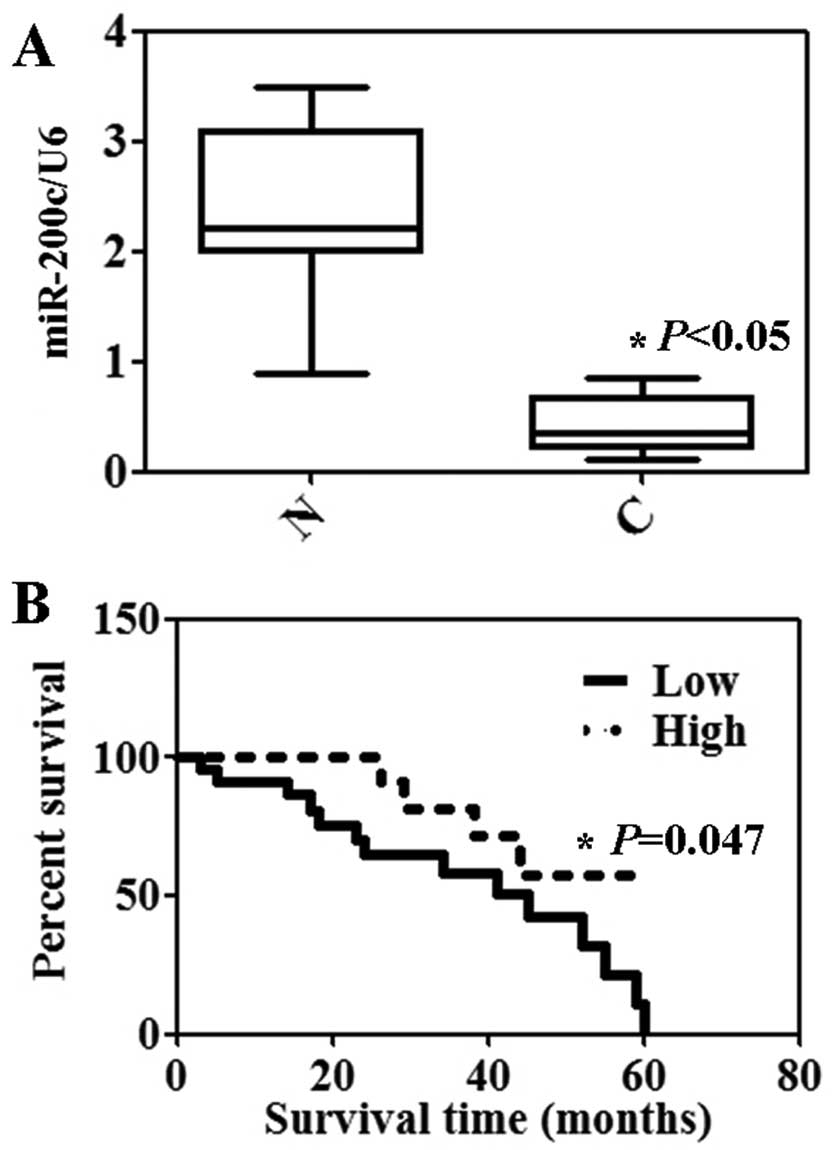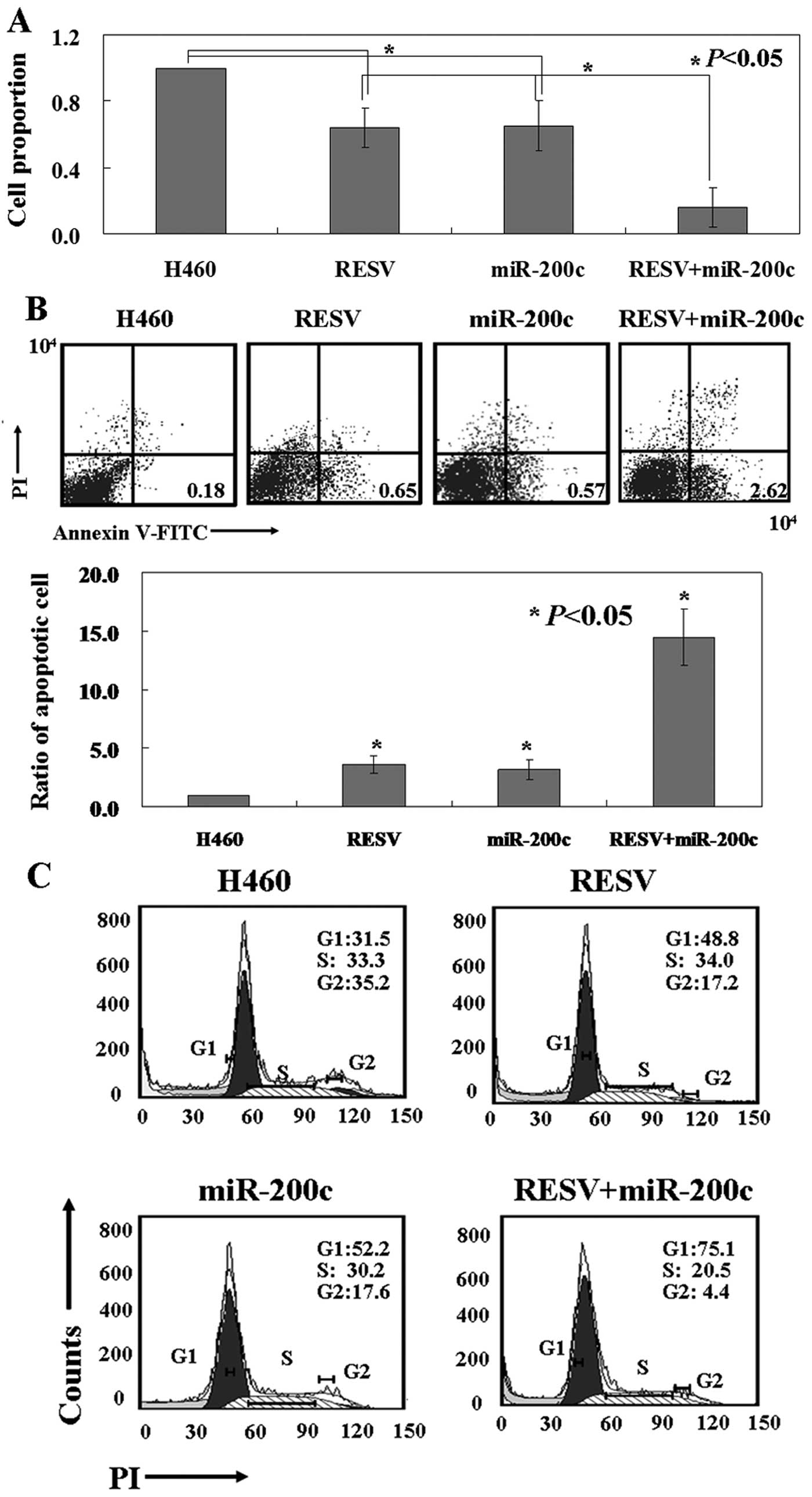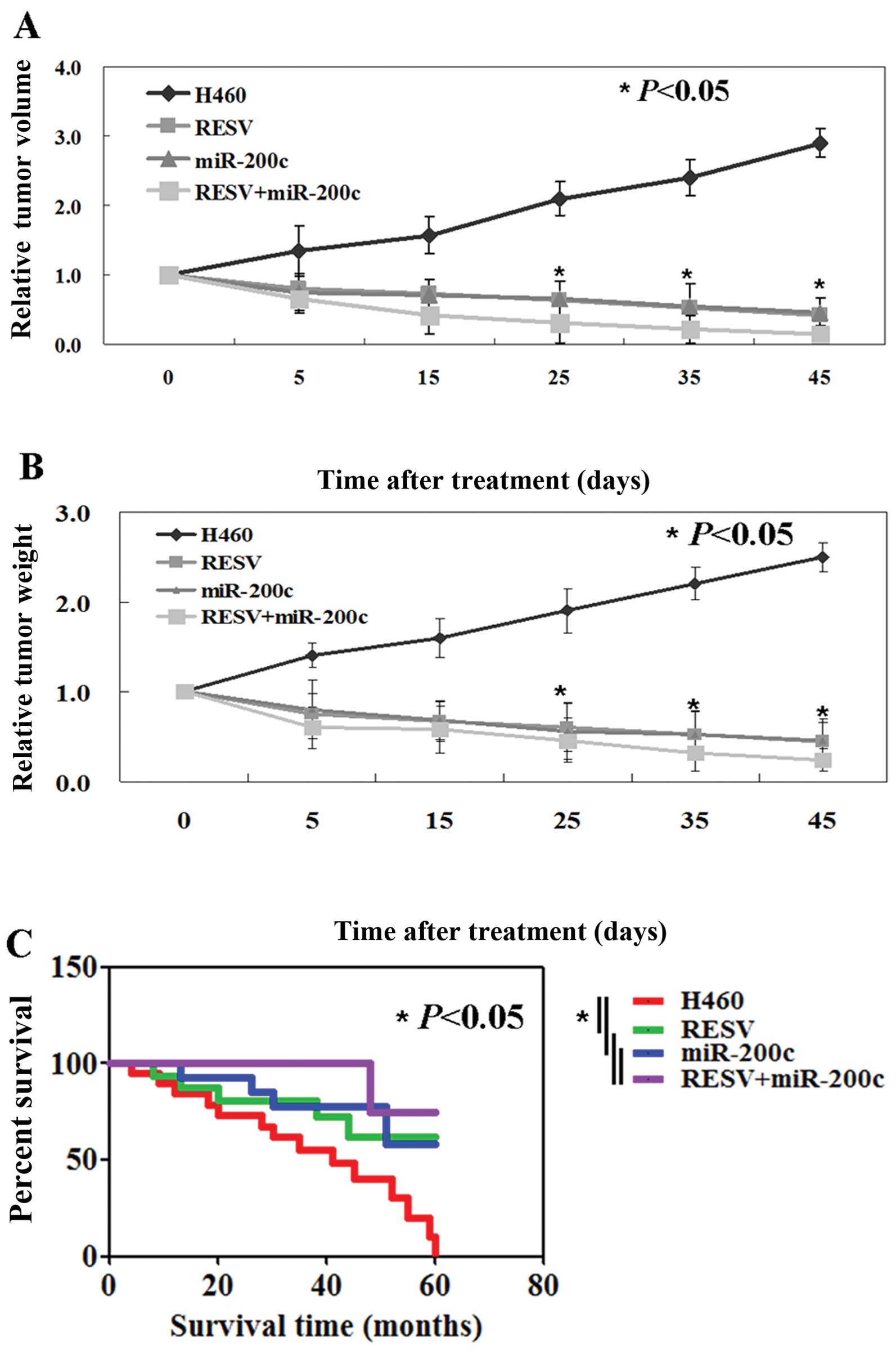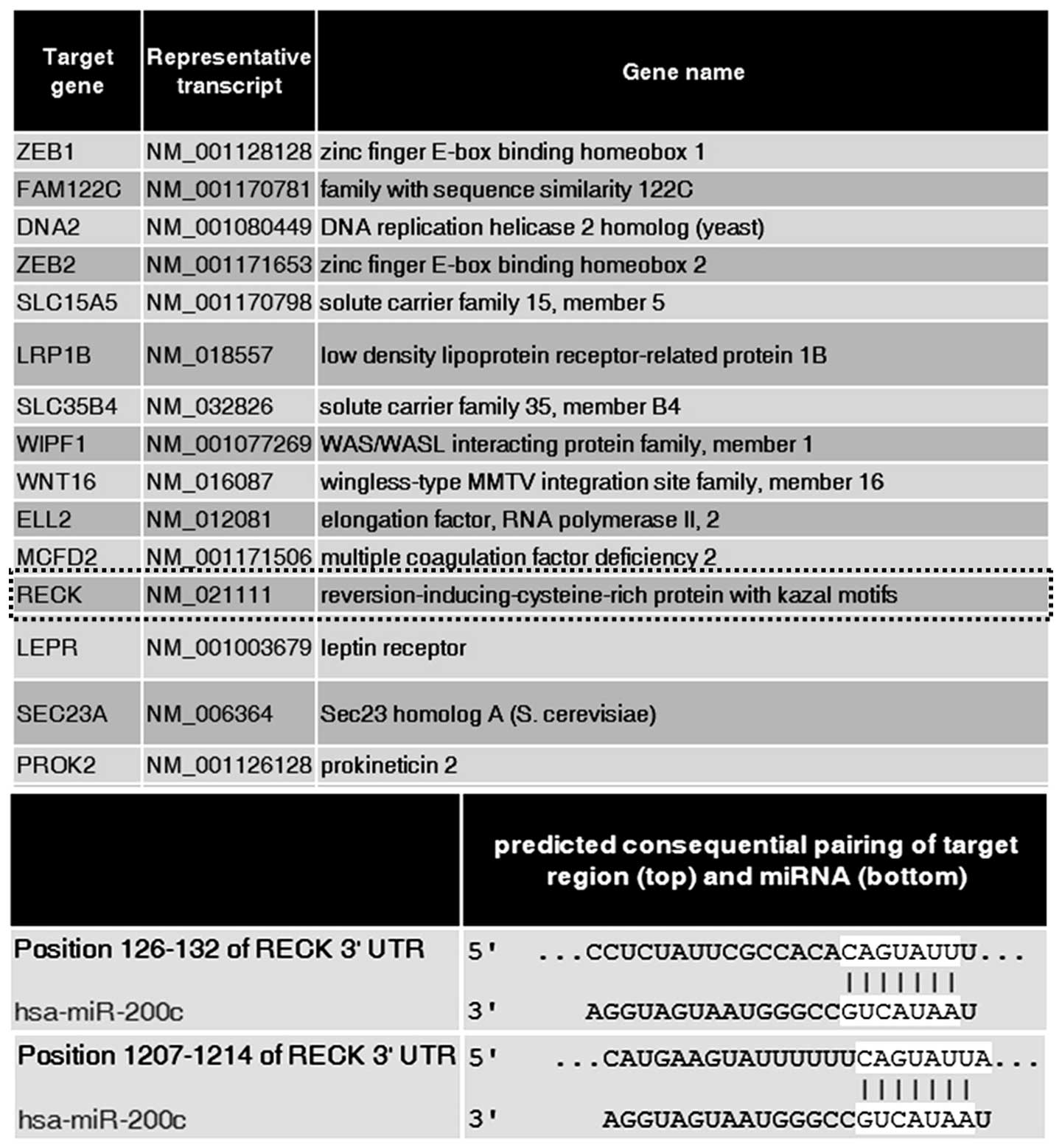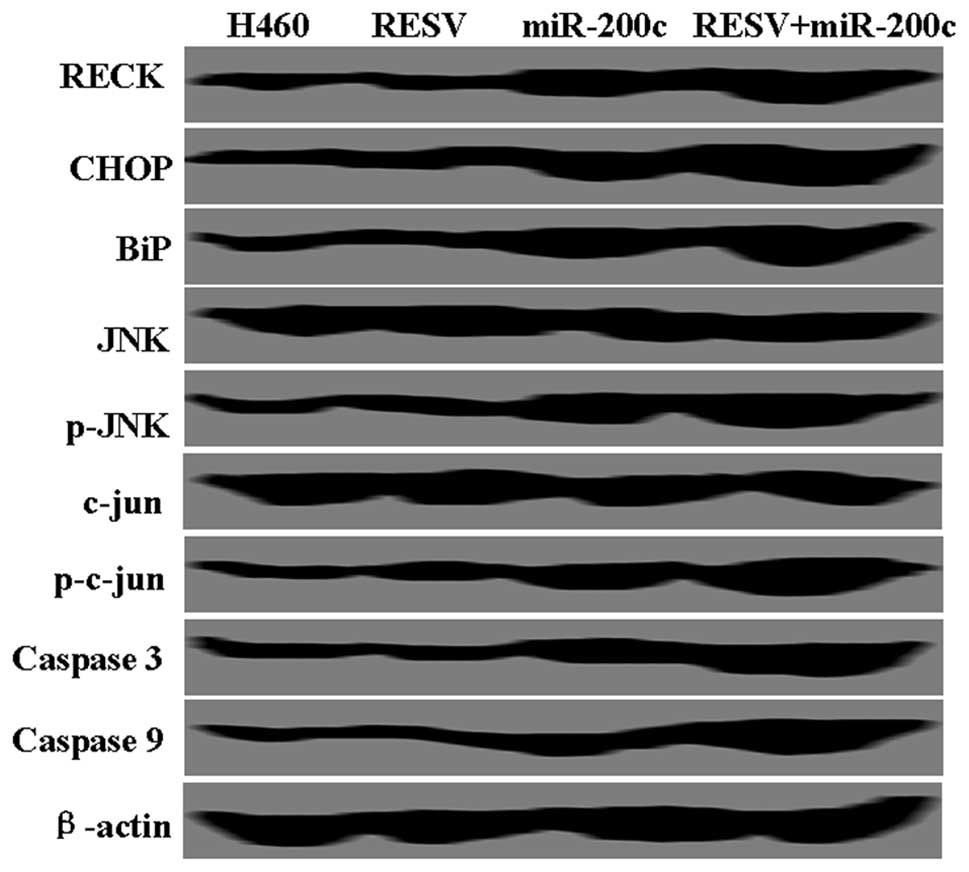Introduction
MicroRNAs (miRs) are evolutionary conserved small
RNAs that modulate gene expression by inhibiting the protein
translation process and/or degrading the respective target
messenger RNA (1). In the past few
years, microRNAs have emerged as promising molecular factors with
potential for clinical applications in cancer diagnosis and therapy
(2,3). The miR-200 family of miRNAs consists
of for five members (miR-200a, miR-200b, miR-200c, miR-141 and
miR-429) expressed in two genomic clusters, one on chromosome
1p36.33 and the other on chromosome 12p12.31 (4). Recent evidence shows that miRNA-200
family members play a central role in the process of
epithelial-mesenchymal transition (EMT) (5,6).
miR-200c has been shown to promote the upregulation of E-cadherin
by directly targeting the transcription factor ZEB1 (7). The importance of EMT in driving
carcinogenesis has been shown in lung, breast, prostate, pancreatic
and liver cancer (8,9).
Resveratrol (RESV)
(trans-3,4,5-trihydroxystilbene), a natural polyphenolic
extracted from red wine, has the potential to inhibit the growth of
several types of cancers such as prostate, lung and colorectal
cancers (10–12). The role of miR-200c and RESV has
been demonstrated in lung cancer, respectively; however, the
synergistic antitumor activity of RESV and miR-200c remains
unclear.
The aim of the present study was to identify
potential roles and mechanisms of RESV and miR-200c in non-small
cell lung cancer (NSCLC). Therefore, we specifically investigated
i) the expression of miR-200c in the NSCLC cell line, H460, and its
role in the proliferation of H460 cells; ii) the possible
associations between miR-200c levels and RESV; and iii) the
possible mechanisms involved in the enhancement of the antitumor
activities of RESV by miR-200c.
Materials and methods
Subjects
Forty-two patients who were diagnosed with primary
NSCLC at the Department of Thoracic Surgery, The First Affiliated
Hospital of China Medical University from January 2006 to December
2010 were included in the present study. All diagnoses were based
on standard laboratory tests (cytology and histology) and confirmed
by computerized tomography of the thorax. None of the patients
underwent radiotherapy or chemotherapy before the operation. The
study was approved by the China Medical University Ethics Committee
and was conducted by the Helsinki Declaration. All patients
provided written informed consent to participate in the study.
H460 cell culture and transfection
The human non-small cell lung cancer cell line
NCI-H460 was purchased from the American Type Culture Collection
(ATCC; Manassas, VA, USA) and grown in RPMI-1640 culture medium
containing 10% fetal bovine serum (FBS), 100 units/ml of
penicillin, and 100 μg/ml streptomycin in humidified air (5%
CO2 atmosphere) at 37°C. Cells were transfected with
hsa-miR-200c (UAAUACUGCCGGGUAAUGAUGGA) (Open Biosystems,
Huntsville, AL, USA) with RNAiFect transfection reagent (Qiagen,
Gaithersburg, MD, USA).
Real-time PCR
Total RNA was isolated from the cell lines and from
lung specimens with TRIzol reagent (Invitrogen) according to the
manufacturer’s instructions. Expression of mature miR-200c was
determined by the TaqMan miRNA assay (Applied Biosystems), and
normalized using the 2−ΔΔCt method relative to U6. All
TaqMan PCRs were conducted in triplicate with a fluorescence-based,
real-time detection method (ABI PRISM 7500 Sequence Detection
System; Applied Biosystems).
Resveratrol treatment and MTT assay
The transfected and untransfected cells were treated
with RESV (Sigma Chemicals, St. Louis, MO, USA). MTT (10 μl, at 5
mg/ml) was added at a final concentration of 500 μg/ml, and the
mixture was further incubated for 1 h at 37°C, and the liquid in
the wells was removed thereafter. DMSO (100 μl) was then added to
each well, and the absorbance was read with a UVmax microplate
reader (Molecular Devices, Sunnyvale, CA, USA) at 560 nm.
Cell apoptosis assay
Cells (5×105) were collected without EDTA
and washed with PBS. A 500 μl binding buffer, 5 μl Annexin V-FITC
and 5 μl propidium iodide (PI) were added into the suspension in
that order and mixed at room temperature in the dark for 10 min.
The examination of apoptosis was performed by flow cytometry within
1 h.
Cell cycle assay
Cells seeded on 6-well plates were treated and then
collected. After being washed with PBS three times, the cell
suspension was fixed with 70% ethanol, and incubated with RNAse A
at 37°C. After being stained with 400 μl PI, the suspension was
evaluated by flow cytometry.
Xenograft assays
All experiments using animals were performed
according to the guidelines of the China Medical University Ethics
Committee. Nude mice (nu/nu), 6–8 weeks of age, were purchased from
Vital River Laboratories Co., Ltd. (Beijing, China). The animal
facility was maintained under conditions of 20±2°C, 50±10%
humidity, and a 12-h light/dark cycle. H460 cells (3×107
in 200 μl) were subcutaneously injected into the axilla of each
mouse. After the tumor diameters reached 3–5 mm, the mice were
divided randomly into three groups and received a 200 μl
intratumoral injection of miR-200c, RESV or both miR-200c and RESV.
Two injections were administered at 10 a.m and 5 p.m. every two
days. The tumor growth was then monitored for 30 days. Every five
days until the end of the experiment, one mouse from each group was
randomly selected to be sacrificed by CO2 asphyxiation,
and tumors were harvested and weighed. The tissue was fixed in 4%
paraformaldehyde for histopathologic analysis. Additional mice
(n=60) were used to establish xenografts to obtain survival curves.
Mice with xenografted tumors (as described above) that reached 3–5
mm in diameter were divided into four groups (n=15 for each).
Survival was monitored until the experiments were terminated due to
the heavy tumor burden.
miRNA target prediction
The miRNA targets predicted by TargetScan
(http://www.targetscan.org/) are based on
the presence of conserved 8mer, 7mer and 6mer sites that match the
seed region of each miRNA (13).
TargetScan also predicts non-conserved sites, additional types of
seed matches that are preferentially conserved in different
species, and sites with mismatches in the seed region that are
compensated by conserved 3′ pairing (14).
Western blot analysis
Tissues and cells were lysed in lysis buffer (20 mM
Tris-HCl, 150 mM NaCl, 2 mM EDTA, 1% Triton X-100) containing a
protease inhibitor cocktail (Sigma). Protein amounts were
quantified using the BCA protein assay kit. Equivalent amounts of
protein (20 μg) were separated using 12% SDS-PAGE and transferred
to a PVDF membrane (Millipore Corporation, Billerica, MA, USA).
Western blot analysis was performed using primary antibodies: RECK
(Santa Cruz Biotechnology, Santa Cruz, CA, USA), stress-activated
protein kinase/JNK antibody (Cell Signaling Technology, Beverly,
MA, USA), phospho-stress activated protein kinase/p-JNK
(Thr183/Tyr185) (Cell Signaling Technology),
CHOP (Abcam), BiP (Cell Signaling Technology), c-jun (Cell
Signaling Technology), phosphorylated c-jun (Ser63)
(Cell Signaling Technology) and β-actin (Millipore). Binding of
each specific antibody was detected with horseradish peroxidase
(HRP)-conjugated respective secondary antibodies (Amersham
Biosciences, Buckinghamshire, UK) and ECL solutions (Amersham
Biosciences).
Statistical analysis
Data were analyzed using GraphPad Prism 5 software.
Statistical analysis was performed using a one-tailed Student’s
t-test (unilateral and unpaired). Kaplan-Meier survival plots were
generated, and comparisons between survival curves were carried out
using the log-rank statistical analysis. P-values <0.05 were
considered to indicate statistically significant differences.
Results
miR-200c is correlated with the 5-year
survival rate of the patients with lung cancer
The level of miR-200c in the tumor tissues was lower
than that in the normal tissues as determined by real-time PCR
(P<0.05; Fig. 1A). To
investigate the association of miR-200c with patient survival, the
survival data from 42 patients with NSCLC were assessed.
Kaplan-Meier analysis showed that miR-200c expression was closely
correlated with the favorable prognosis of patients with NSCLC
(P<0.05; Fig. 1B).
Growth inhibitory effects of RESV in
miR-200c-expressing H460 cells
A slower growth rate of the miR-200c-expressing H460
cells was noted when compared with the untreated cells by using MTT
assay (P<0.05; Fig. 2A). Annexin
V/PI double staining showed a higher level of apoptosis in the
miR-200c-expressing H460 cells (P<0.05; Fig. 2B). PI staining of cells revealed
that miR-200c-expressing H460 cells were arrested in the
G1 phase (Fig. 2C). RESV
also inhibited proliferation, induced apoptosis and G1
arrest in H460 cells (Fig. 2).
Notably, RESV showed stronger antitumor activity in the
miR-200c-positive H460 cells than that in the negative miR-200c
H460 cells. Furthermore, we confirmed that the activity of RESV in
the miR-200c-positive H460 cells was not a simple summation of RESV
and miR-200c (Fig. 2).
RESV and miR-200c inhibit tumor growth
and prolong the survival rate of mice in vivo
We next determined whether RESV and miR-200c display
antitumor activities in established xenograft tumor models. As
shown in Fig. 3A, the tumor volumes
of the RESV-treated and the miR-200c-treated mice were less than
that of the untreated mice (P<0.05). Similarly, tumor weights
for the RESV-treated group and the miR-200c-treated group were also
significantly reduced when compared to that of the untreated group
(P<0.05; Fig. 3B). We also found
that the RESV-treated and miR-200c-treated mice displayed a
prolonged survival rate when compared to the untreated mice
(P<0.05; Fig. 3C). The results
of the in vitro studies demonstrated that the combined
treatment with RESV and miR-200c had the strongest antitumor
activity in the established xenograft tumor models.
Mechanism of RESV-induced apoptosis in
the miR-200c-positive H460 cells
To clarify the mechanism of RESV in the
miR-200c-positive H460 cells, TargetScan was used to determine the
predicted target genes of miR-200c. The prediction results are
partly shown in Fig. 4.
Furthermore, we focused on an ER stress-related protein, RECK. As
shown in Fig. 5, RECK expression
was upregulated following miR-200c transfection. Expression of ER
stress molecules (BiP and CHOP) was significantly increased in the
miR-200c-transfected cells. No significant changes in JNK and c-jun
were detected in the transfected cells. However, phosphorylated JNK
and c-jun were increased. We then confirmed that caspase-3 and
caspase-9 were activated in the transfected cells (Fig. 5). RESV further enhanced RECK, BiP,
CHOP, JNK, c-jun, caspase-3 and caspase-9 expression in the
miR-200c-transfected cells but not in the untransfected cells
(Fig. 5).
Discussion
In the present study, we showed a highly significant
correlation between relative miR-200c expression and the survival
rate of the patients with NSCLC, indicating that its expression may
be used as a valuable marker of lung cancer prognosis. Tang et
al (15) also found that
miR-200c was downregulated in gastric cancer specimens. Ceppi et
al (16) confirmed that loss of
miR-200c expression induces an aggressive, invasive, and
chemoresistant phenotype in non-small cell lung cancer. Consistent
with their studies, we found that miR-200c could induce apoptosis
and G1 arrest in H460 cells. Furthermore, we found that
RESV exhibited a stronger antitumor activity in the
miR-200c-positive H460 cells than that in the miR-200c-negative
H460 cells.
The main aim of the present study was to determine
the potential mechanism of RESV in miR-positive H460 cells.
Firstly, we identified the regulation of miR-200c by potential
molecular targets by using TargetScan, such as ZEB1 and ZEB2. Then
we focused on reversion-inducing cysteine-rich protein with Kazal
motifs (RECK), a membrane bound protein. Several studies have shown
that RECK levels are significantly downregulated in human
pancreatic, mammary, lung, prostate and colorectal cancers, as well
as in hepatocarcinoma and neuroblastoma, when compared with the
levels in the normal surrounding tissues (17–20).
We confirmed that upregulation of miR-200c in H460 cells could
increase RECK expression. The inhibitory role of RECK expression in
cancer cells has been demonstrated both in previous (21) and in the present study. In addition
to RECK expression, ER stress was detected in H460 cells. Chen
et al (22) also found that
RECK regulated endoplasmic reticulum stress response and enhanced
cisplatin-induced cell death in neuroblastoma cells. The alteration
of the ER molecular chaperone GRP78/BiP expression levels can
inhibit tumor growth in vivo (23). Another study also confirmed that ER
stress-induced apoptosis is highly dependent on the upregulation of
the UPR-inducible transcription factor CHOP (24). Consistent with previous studies, we
found that the levels of BiP and CHOP in miR-200c-positive H460
cells were higher than levels in the untreated cells.
This is the first study to explore the role of
miR-200c in controlling RECK expression in H460 cell lines. Our
data showed that miR-200c expression sensitizes H460 cells to RESV,
and this is likely due to RECK expression.
Acknowledgements
We thank Dr Ming-Yu Li for carefully proofreading
the manuscript and for providing valuable comments.
References
|
1
|
Ryan BM, Robles AI and Harris CC: Genetic
variation in microRNA networks: the implications for cancer
research. Nat Rev Cancer. 10:389–402. 2010. View Article : Google Scholar : PubMed/NCBI
|
|
2
|
Kasinski AL and Slack FJ: MicroRNAs en
route to the clinic: progress in validating and targeting microRNAs
for cancer therapy. Nat Rev Cancer. 11:849–864. 2011. View Article : Google Scholar : PubMed/NCBI
|
|
3
|
Edwards JK, Pasqualini R, Arap W and Calin
GA: MicroRNAs and ultraconserved genes as diagnostic markers and
therapeutic targets in cancer and cardiovascular diseases. J
Cardiovasc Transl Res. 3:271–279. 2010. View Article : Google Scholar : PubMed/NCBI
|
|
4
|
Tryndyak VP, Beland FA and Pogribny IP:
E-cadherin transcriptional down-regulation by epigenetic and
microRNA-200 family alterations is related to mesenchymal and
drug-resistant phenotypes in human breast cancer cells. Int J
Cancer. 126:2575–2583. 2009.PubMed/NCBI
|
|
5
|
Korpal M, Lee ES, Hu G and Kang Y: The
miR-200 family inhibits epithelial-mesenchymal transition and
cancer cell migration by direct targeting of E-cadherin
transcriptional repressors ZEB1 and ZEB2. J Biol Chem.
283:14910–14914. 2008. View Article : Google Scholar : PubMed/NCBI
|
|
6
|
Park SM, Gaur AB, Lengyel E and Peter ME:
The miR-200 family determines the epithelial phenotype of cancer
cells by targeting the E-cadherin repressors ZEB1 and ZEB2. Genes
Dev. 22:894–907. 2008. View Article : Google Scholar : PubMed/NCBI
|
|
7
|
Hurteau GJ, Carlson JA, Roos E and Brock
GJ: Stable expression of miR-200c alone is sufficient to regulate
TCF8 (ZEB1) and restore E-cadherin expression. Cell Cycle.
8:2064–2069. 2009. View Article : Google Scholar : PubMed/NCBI
|
|
8
|
Hugo H, Ackland ML, Blick T, et al:
Epithelial-mesenchymal and mesenchymal-epithelial transitions in
carcinoma progression. J Cell Physiol. 213:374–383. 2007.
View Article : Google Scholar : PubMed/NCBI
|
|
9
|
Lee TK, Poon RT, Yuen AP, et al: Twist
overexpression correlates with hepatocellular carcinoma metastasis
through induction of epithelial-mesenchymal transition. Clin Cancer
Res. 12:5369–5376. 2006. View Article : Google Scholar
|
|
10
|
Miki H, Uehara N, Kimura A, et al:
Resveratrol induces apoptosis via ROS-triggered autophagy in human
colon cancer cells. Int J Oncol. 40:1020–1028. 2012.PubMed/NCBI
|
|
11
|
Sheths S, Jajoo S, Kaur T, et al:
Resveratrolreducesprostate cancer growth and metastasis by
inhibiting the Akt/microRNA-21 pathway. PLoS One. 7:e516552012.
View Article : Google Scholar : PubMed/NCBI
|
|
12
|
Yin HT, Tian QZ, Guan L, Zhou Y, Huang XE
and Zhang H: In vitro and in vivo evaluation of the antitumor
efficiency of resveratrol against lung cancer. Asian Pac J Cancer
Prev. 14:1703–1706. 2013. View Article : Google Scholar : PubMed/NCBI
|
|
13
|
Lewis BP, Burge CB and Bartel DP:
Conserved seed pairing, often flanked by adenosines, indicates that
thousands of human genes are microRNA targets. Cell. 120:15–20.
2005. View Article : Google Scholar : PubMed/NCBI
|
|
14
|
Jan CH, Friedman RC, Ruby JG and Bartel
DP: Formation, regulation and evolution of Caenorhabditis
elegans 3′UTRs. Nature. 469:97–101. 2011. View Article : Google Scholar
|
|
15
|
Tang H, Deng M, Tang Y, et al: miR-200b
and miR-200c as prognostic factors and mediators of gastric cancer
cell progression. Clin Cancer Res. 19:5602–5612. 2013. View Article : Google Scholar : PubMed/NCBI
|
|
16
|
Ceppi P, Mudduluru G, Kumarswamy R, et al:
Loss of miR-200c expression induces an aggressive, invasive, and
chemoresistant phenotype in non-small cell lung cancer. Mol Cancer
Res. 8:1207–1216. 2010. View Article : Google Scholar : PubMed/NCBI
|
|
17
|
Furumoto K, Arii S, Mori A, et al: RECK
gene expression in hepatocellular carcinoma: correlation with
invasion-related clinicopathological factors and its clinical
significance. Reverse-inducing-cysteine-rich protein with Kazal
motifs. Hepatology. 33:189–195. 2001. View Article : Google Scholar
|
|
18
|
Span PN, Sweep CG, Manders P, et al:
Matrix metalloproteınase inhibitor reversion-inducing cysteine-rich
protein with Kazal motif a prognostic marker for good clinical
outcome in human breast carcinoma. Cancer. 97:2710–7215. 2003.
|
|
19
|
Masui T, Doi R, Koshiba T, et al: RECK
expression in pancreatic cancer: its correlation with lower
invasiveness and better prognosis. Clin Can Res. 9:1779–1784.
2003.PubMed/NCBI
|
|
20
|
Takeuchi T, Hisanaga M, Nagao M, et al:
The membrane-anchored matrix metalloproteí nase (MMP) regulator
RECK in combination with MMP-9 serves as an informative prognostic
indicator for colorectal cancer. Clin Cancer Res. 10:5572–5579.
2004.
|
|
21
|
Lei L, Huang Y and Gong W: Inhibition of
miR-92b suppresses nonsmall cell lung cancer cells growth and
motility by targeting RECK. Mol Cell Biochem. 387:171–176. 2013.
View Article : Google Scholar : PubMed/NCBI
|
|
22
|
Chen Y, Tsai YH and Tseng SH: RECK
regulated endoplasmic reticulum stress response and enhanced
cisplatin-induced cell death in neuroblastoma cells. Surgery.
154:968–979. 2013. View Article : Google Scholar : PubMed/NCBI
|
|
23
|
Moenner M, Pluquet O, Bouchecareilh M, et
al: Integrated endoplasmic reticulum stress responses in cancer.
Cancer Res. 67:10631–10634. 2007. View Article : Google Scholar : PubMed/NCBI
|
|
24
|
Tamaki N, Hatano E, Taura K, et al: CHOP
deficiency attenuates cholestasis-induced liver fibrosis by
reduction of hepatocyte injury. Am J Physiol Gastrointest Liver
Physiol. 294:G498–G505. 2008. View Article : Google Scholar : PubMed/NCBI
|















